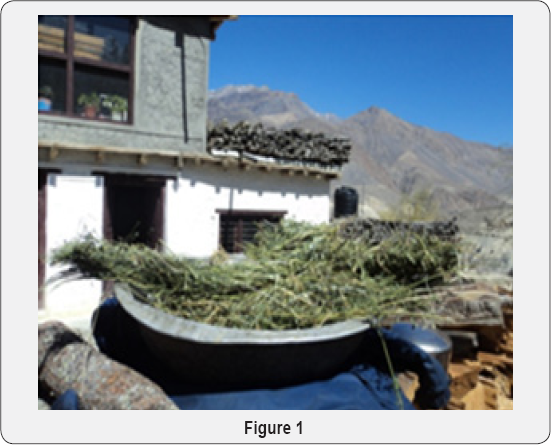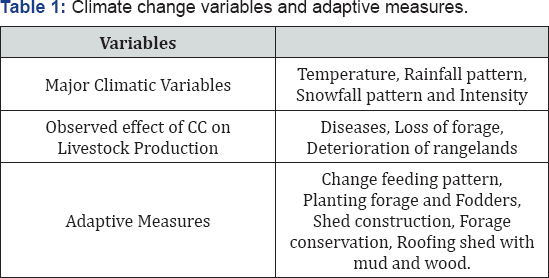Climate Change and Local Mitigating Strategies that the Livestock Holders have Adopted in Nepal-Juniper Publishers
JUNIPER PUBLISHERS-OPEN ACCESS JOURNAL OF DAIRY & VETERINARY SCIENCES
Abstract
Livestock is a major source of income, food security, transportation, and manure for the peoples of this region for fulfilling multiple economic, social and risk management of the family. The impact of climate change is expected to heighten the vulnerability of livestock systems and trigger the livestock holders to chronic poverty. Tools like Focal group discussion and key informant interview was done. Some of the locally adopted measures to mitigate with changing climate were changing feeding pattern, planting forage and fodder trees, renovation of the sheds, proper vaccination, deworming and dipping of animals to prevent disease and parasites and conservation of pasture and local breeds.
Keywords: Food security; Renovation; Feeding pattern; Vaccination; Conservation.
Abbreviations: FGD: Focal Group Discussion; FMD: Foot and Mouth Disease; PPR: PesteDes Petits Ruminants; KII: Key Informant Interview.
Introduction
Climate change is referred as a change in average weather conditions in longer-term. Nepal has already seen visible effects of climate change like changing patterns of monsoon rains, thick cloud cover, cold waves, and melting of glaciers resulting effects in natural resources, biodiversity and agriculture. Nepal's temperature is rising by about 0.41 °C per decade. Warming is much higher in mountains and relatively lower in hills and terai (0.8 °C, 0.6 °C and 0.4 °C respectively). The effect of climate change has been experienced by the farmers of mountain regions. Low and marginal farmers having limited resources are at high risk resulting food insecurity. Livestock and agriculture is a part of living in this region. As climate is changing and people have started to mitigate on their own. Impact of climate change is seen in water availability, forage and forage production, quality of the rangeland and pasture, decrease out puts of agriculture, animal health and diseases and ultimately decrease in the production. As livestock assets are the major source of income, food security, transportation, and manure for the peoples of this region for fulfilling multiple economic, social and risk management of the family. The impact of climate change is expected to heighten the vulnerability of livestock systems and reinforce existing factors that are affecting livestock production systems, such as rapid population and economic growth, rising demand for food (including livestock) and products, conflict over scarce resources (land tenure, water, biofuels, etc). For rural communities, losing livestock assets could trigger a collapse into chronic poverty and have a lasting effect on livelihoods. Different climatic effects like higher temperatures and changing rainfall patterns change in snowing pattern and amount, extreme drought. Livestock in rural mountain have limited options for the feed and forage, poor access to health services like vaccination, deworming, drenching and treatments. Further more impact of climate change in availability of forage and forage, range lands, by products of crops is causing malnutrition and deteriorating the health of these animals. This study reveals the major mitigation strategies the people has applied or invented is discussed.
Materials and Methods
This study is carried out in Mustang district which is one of the mountainous district of Nepal. Major of the population rear livestock in this district. Different local level mitigating strategies the livestock rearing farmers used by the farmers was identified from the focal group discussion and key person interview. Information about the climate change, effects, local mitigation strategies used by the livestock farmers was obtained.
Results
Key informant interview
The livestock holders have experienced climate change in the region. The major variables found were the timing and amount of snowfall, temperature, and amount and intensity of rainfall. Key informant interview (KII) was conducted using the knowledgeable persons which include women and senior citizens rearing livestock. Climate is changing as compared to past ten years, amount and frequency of snowfall has decreased. The snow fall has shift from September-November to February-April. They also concluded that due to less snowfall there is reduction in the growth of grasses for their livestock in the rangeland so they have experienced lack of forage for the goat, sheep and yak causing reduction in the growth and production of these animals. Some time unseasonal snowfall has cause huge loss of yak, goat and chyangra in the pasture. Livestock diseases like FMD, dhairrhoea, fasciola, mange are increasing as compared to last ten years [1-5]. Disease like FMD in cattle and PPR in the small ruminants which were not present many years back is causing death of large number of animals. External parasites like lice, ticks, flea, and mites are also increasing. As mitigating strategies people are conserve forage for the lean season. Improving the shed, thatching shed with woods and mud, using beddings, giving hot gruel, feeding animals indoor, and keeping the young ones warm to prevent the animal from adverse climatic effects.
FGD (Focus Group Discussion

To know the community perception on climate change and strategies that have been applying to cope with climate change a focal group discussion was conducted including ten to fifteen persons of the community involving men, women, and underprivileged people. Discussion on climate related issue was done. Major impacts in climate change included unusual snowfall, high rainfall, loss of water sources, landslides, long drought, and decrease in production of agricultural products, livestock death due to untimely snowfall, outbreak of new disease like FMD in cattle, PPR in goat and sheep, increase in the ticks, lice, mites and insufficient and quality grass in the pasture (Figure1). According to the Key informant interview and focal group discussion following local mitigation strategies were adopted by the livestock rearing farmers of Mustang (Table 1).

Change in livestock feeding pattern: Free grazing is common rearing pattern of this region but now a day's people in this region have changed their livestock rearing pattern of their livestock. Whenever the grasses are available in the grazing pasture they graze the livestock and when there is adverse climatic condition and the grazing pasture lack the nutritious grass, people stall feed their animals with crop by-products, hay from native species of grasses like Elymus nutans (furcha), Pennisetum flaccidum (dhimchi), Medicago sativa ssp. falcata (kote), is given by the farmers but buying of these grasses to feed the animals is increasing extra investment in the livestock sector. Some people also buying hay and straw from the other district to feed the animals. Potato grown here is given to the animals as concentrate when the production is sufficient for human consumption. Young calves and lactating females are given special attention and fed with better hay, hot gruels and some potatoes. Young calves are given preparation from naked barley. Due to the adverse climatic conditions people are putting extra investments in livestock feeding by buy grasses, hay, straw and crop by-products [4-10].

Plant fodder and forage of this region: Due to the topography and soil condition of this district only a few species of forage and fodders grows in this area. Fodder trees like Bish (Aconitum spicatum) and Bhote pipal is grown by the people for the fodder and wood for the roofing and flooring of the animal shed. Improved varieties of forage like oat, Teosenty spp, Ray grass and white clover was introduced in the district but due to lack of landarea for cultivation, farmers has not practiced the cultivation these forage. In order to meet the nutrition requirement for the animals in harsh climatic condition farmers make hay from native species like Elymus nutans (furcha), Pennisetum flaccidum (dhimchi), Medicago sativa ssp. falcata (kote), and other local grasses which grows in the district (Figure 2).
Renovation of traditional sheds: In the past animals were kept in open area but due to uncertainty in the climatic pattern people now started building shed with thatched roof and they used mud and wood to thatch the roof of the shed. As a result the animals are protected from snowfall, rainfall and windy condition. Uncertainty in the weather and climate has caused death of large numbers of goat and cattle in this region so people have now renovated the traditional sheds. Not only that the use the leaves of pine trees for the bedding [11-20].
Regular vaccination, deworming and dipping of animals: As the climate change is increase external parasites like ticks, mites and lice. People have now started to built dipping tank in a community level and dip the sheep and goats. Regular vaccination against PPR, FMD is now practiced by the farmers. Deforming is done in every six months of time to prevent the internal parasites [21-25].
Conservation of pasture: As the quality and the amount of grasses is decreasing in the pasture land people have now started to conserve the rangeland by fencing and promoting rotational grazing in community level.
Promotion of the indigenous Breeds: The indigenous breeds like chyangra (himalayan Goat), Bhanglung Sheep, yak and lulu cattle are reared by the peoples; these animals can survive in limited resources and harsh climate. So people are preserving these species as they are the source of meat, milk, wool, transportation and manure [26-28].
Conclusion
Climate is changing and is affecting the livestock. People are using their local knowledge and experience to mitigate with the changing climate. Some new interventions like introduction of suitable forages and fodders trees, promotion of the locally available grasses, education and training on hay and silage making techniques, livestock insurance facilities, vaccination and treatment, training on management of the sheep, goat and livestock should be developed and given to the farmers to prevent and coop with the changing climate. Long term mitigation strategies plans for the livestock holders in this district should be formulated from the government to promote the livestock holding farmers as it is the major source of income and food security for the peoples.
For more Open Access Journals in Juniper Publishers please click on: https://juniperpublishers.com/open-access.php
For more articles in Open Access Journal of Dairy & Veterinary sciences please click on: https://juniperpublishers.com/jdvs/index.php



Comments
Post a Comment